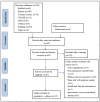Efficacy of Horticultural Therapy on Positive, Negative, and Affective Symptoms in Individuals with Schizophrenia: A Systematic Review and Meta-Analysis of Randomized Controlled Trials
- PMID: 39517317
- PMCID: PMC11545822
- DOI: 10.3390/healthcare12212104
Efficacy of Horticultural Therapy on Positive, Negative, and Affective Symptoms in Individuals with Schizophrenia: A Systematic Review and Meta-Analysis of Randomized Controlled Trials
Abstract
Background/Objectives: Positive symptoms, negative symptoms, and emotional disturbances are core features of schizophrenia. Although horticultural therapy (HT) has shown promise as an adjunctive treatment, evidence supporting its effectiveness remains limited. This systematic review and meta-analysis aimed to assess the impact of HT on total symptoms, positive symptoms, negative symptoms, and emotional disturbances in individuals with schizophrenia. Methods: We conducted a search for randomized controlled trials (RCTs) published up to March 2024 across multiple databases, including PubMed, Embase, Cochrane Library, CINAHL, CEPS, CNKI, Wanfang, and Yiigle. A random-effects model was employed to calculate the standardized mean difference (SMD). Results: A total of 35 studies enrolling 2899 participants were included. Our results indicated that, in the short term (≦3 months), HT has moderate to large effect sizes on total symptoms (SMD = 0.690, 95% CI 0.463 to 0.916), positive symptoms (SMD = 0.695, 95% CI 0.038 to 1.351), negative symptoms (SMD = 0.681, 95% CI 0.395 to 0.967), depression (SMD = 0.646, 95% CI 0.334 to 0.959), and anxiety (SMD = 0.627, 95% CI 0.364 to 0.890), with more pronounced benefits for anxiety symptoms in patients with a shorter duration of illness. In the long term (>3 months), HT shows large effect sizes for total symptoms (SMD = 1.393, 95% CI 0.858 to 1.928), negative symptoms (SMD = 1.389, 95% CI 0.935 to 1.842), anxiety (SMD = 1.541, 95% CI 1.042 to 2.040), and moderate to large effect sizes for positive symptoms (SMD = 0.667, 95% CI 0.077 to 1.258) and depression (SMD = 0.707, 95% CI 0.198 to 1.217). Additionally, longer weekly treatment durations are associated with better outcomes for total symptoms and negative symptoms. Schizophrenia patients with more severe initial symptoms may be potential responders to HT. Conclusions: These findings support the efficacy of HT in improving symptoms and emotional well-being in schizophrenia patients. Further trials with more rigorous designs are warranted to confirm these benefits.
Keywords: emotions; horticultural therapy; meta-analysis; psychiatric symptoms; schizophrenia.
Conflict of interest statement
The authors declare no conflicts of interest.
Figures







Similar articles
-
Effects of Visual Art Therapy on Positive Symptoms, Negative Symptoms, and Emotions in Individuals with Schizophrenia: A Systematic Review and Meta-Analysis.Healthcare (Basel). 2024 Jun 6;12(11):1156. doi: 10.3390/healthcare12111156. Healthcare (Basel). 2024. PMID: 38891231 Free PMC article. Review.
-
Mobile apps to reduce depressive symptoms and alcohol use in youth: A systematic review and meta-analysis: A systematic review.Campbell Syst Rev. 2024 Apr 26;20(2):e1398. doi: 10.1002/cl2.1398. eCollection 2024 Jun. Campbell Syst Rev. 2024. PMID: 38680950 Free PMC article. Review.
-
Folic acid supplementation and malaria susceptibility and severity among people taking antifolate antimalarial drugs in endemic areas.Cochrane Database Syst Rev. 2022 Feb 1;2(2022):CD014217. doi: 10.1002/14651858.CD014217. Cochrane Database Syst Rev. 2022. PMID: 36321557 Free PMC article.
-
Behavioural modification interventions for medically unexplained symptoms in primary care: systematic reviews and economic evaluation.Health Technol Assess. 2020 Sep;24(46):1-490. doi: 10.3310/hta24460. Health Technol Assess. 2020. PMID: 32975190 Free PMC article.
-
Music therapy for depression.Cochrane Database Syst Rev. 2017 Nov 16;11(11):CD004517. doi: 10.1002/14651858.CD004517.pub3. Cochrane Database Syst Rev. 2017. PMID: 29144545 Free PMC article. Review.
References
Publication types
Grants and funding
LinkOut - more resources
Full Text Sources


